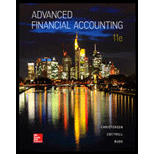
Concept explainers
a.
To compute: The book value of all the assets transferred by the parent to subsidiary.
Introduction: Internal expansion refers to situation in a company forms a subsidiary by transferring some of its assets and liabilities and in exchange of ownership shares. Shares of the subsidiary is either provided to the shareholders in addition to their existing shares (Spin off) or in exchange of their existing shares (split off).
b.
To compute: The amount that parent would report as investment in subsidiary.
Introduction: Internal expansion refers to situation in a company forms a subsidiary by transferring some of its assets and liabilities and in exchange of ownership shares. Shares of the subsidiary is either provided to the shareholders in addition to their existing shares (Spin off) or in exchange of their existing shares (split off).
c.
To compute: The number of shares that subsidiary company issued to parent.
Introduction: Internal expansion refers to situation in a company forms a subsidiary by transferring some of its assets and liabilities and in exchange of ownership shares. Shares of the subsidiary is either provided to the shareholders in addition to their existing shares (Spin off) or in exchange of their existing shares (split off).
d.
To discuss: The impact that transfer of assets and accounts payable would have on the amount reported by parent company as total assets.
Introduction: Internal expansion refers to situation in a company forms a subsidiary by transferring some of its assets and liabilities and in exchange of ownership shares. Shares of the subsidiary is either provided to the shareholders in addition to their existing shares (Spin off) or in exchange of their existing shares (split off).
e.
To explain: The effect that transfer of assets and accounts payable would have, on the amount of outstanding shares, reported by the stand alone and consolidated financial statements of parent company.
Introduction: Internal expansion refers to situation in a company forms a subsidiary by transferring some of its assets and liabilities and in exchange of ownership shares. Shares of the subsidiary is either provided to the shareholders in addition to their existing shares (Spin off) or in exchange of their existing shares (split off).
Want to see the full answer?
Check out a sample textbook solution
Chapter 1 Solutions
Advanced Financial Accounting
- Can you help me solve this general accounting question using the correct accounting procedures?arrow_forwardI need the correct answer to this general accounting problem using the standard accounting approach.arrow_forwardI am searching for the accurate solution to this general accounting problem with the right approach.arrow_forward
- Please provide the correct answer to this general accounting problem using valid calculations.arrow_forwardCan you solve this general accounting problem using appropriate accounting principles?arrow_forwardSarah is the president and general manager of the operation. Sarah has been very proactive in growing the business. She has met with her banker to discuss expanding the facilities and equipment with another $150,000 loan. Their first loan for $150,000 was secured by the industrial-size food production equipment purchased with the loan. The banker now demands an audit of the corporate financial statements before releasing another loan to the company. Sarah has offered to place the corporate account receivables up as collateral to secure the second loan. Based on revenue projections by her sister Jillian's sales team, Sarah believes that the company will not have trouble paying down the loan in a short period of time. Kim's assistant, Henry, monitors the production and shipment of Smackey Dog Food's regular line of products. Henry takes pride in his work and is involved in every facet of the operation. With only one other warehouse employee to help, Henry personally is involved in…arrow_forward
- I need assistance with this financial accounting problem using appropriate calculation techniques.arrow_forwardDodge Industries has the following data: direct labor $185,000, direct materials used $210,000, total manufacturing overhead $195,000, and beginning work in process $45,000. Compute total manufacturing costs and total cost of work in process.arrow_forwardI am looking for the most effective method for solving this financial accounting problem.arrow_forward
